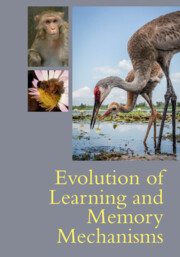Book contents
- Evolution of Learning and Memory Mechanisms
- Evolution of Learning and Memory Mechanisms
- Copyright page
- Contents
- Figures
- Tables
- Contributors
- Preface
- Introduction
- Part I Evolution of Learning Processes
- 1 Learning and Memory in the Nematode Caenorhabditis elegans
- 2 Adaptive Evolution of Learning and Memory in a Model Lineage
- 3 Learning in Insects: Perspectives and Possibilities
- 4 Experimental Evolution and Mechanisms for Prepared Learning
- 5 Evolutionary Processes Shaping Learning Ability in Insects
- 6 Brain and Spatial Cognition in Amphibians
- 7 Pavlovian Conditioning, Survival, and Reproductive Success
- 8 Compensatory Responses to Wildlife Control
- 9 Relational Memory Functions of the Hippocampal Pallium in Teleost Fish
- 10 Mechanisms Underlying Absolute and Relative Reward Value in Vertebrates
- 11 The Optimality of “Suboptimal” Choice
- 12 A Behavior Systems Framework
- 13 Dissociable Learning Processes
- 14 Social Learning Strategies
- 15 How Learning Affects Evolution
- Part II Evolution of Memory Processes
- Index
- References
1 - Learning and Memory in the Nematode Caenorhabditis elegans
from Part I - Evolution of Learning Processes
Published online by Cambridge University Press: 26 May 2022
- Evolution of Learning and Memory Mechanisms
- Evolution of Learning and Memory Mechanisms
- Copyright page
- Contents
- Figures
- Tables
- Contributors
- Preface
- Introduction
- Part I Evolution of Learning Processes
- 1 Learning and Memory in the Nematode Caenorhabditis elegans
- 2 Adaptive Evolution of Learning and Memory in a Model Lineage
- 3 Learning in Insects: Perspectives and Possibilities
- 4 Experimental Evolution and Mechanisms for Prepared Learning
- 5 Evolutionary Processes Shaping Learning Ability in Insects
- 6 Brain and Spatial Cognition in Amphibians
- 7 Pavlovian Conditioning, Survival, and Reproductive Success
- 8 Compensatory Responses to Wildlife Control
- 9 Relational Memory Functions of the Hippocampal Pallium in Teleost Fish
- 10 Mechanisms Underlying Absolute and Relative Reward Value in Vertebrates
- 11 The Optimality of “Suboptimal” Choice
- 12 A Behavior Systems Framework
- 13 Dissociable Learning Processes
- 14 Social Learning Strategies
- 15 How Learning Affects Evolution
- Part II Evolution of Memory Processes
- Index
- References
Summary
Caenorhabditis elegans is a microscopic, free-living nematode species that has been studied as a model organism for learning and memory. With a nervous system consisting of 302 neurons, its accessible anatomy accommodates an incredible capacity to support a wide range of behaviors to navigate in its surroundings. In this chapter, we review both the classic and cutting-edge studies on learning and memory in C. elegans. These findings illustrate that learning allows C. elegans to adaptively adjust its behaviors to the environment as a result of experiences and plays a key role in promoting the organism’s fitness. Learning and memory in simple organisms like C. elegans is mediated by complex neural and molecular mechanisms. Mechanisms of learning and memory elucidated from C. elegans studies show convergence onto the learning mechanisms discovered in other species, suggesting that a large portion of the neural principles of learning and memory are rooted in evolution.
Keywords
- Type
- Chapter
- Information
- Evolution of Learning and Memory Mechanisms , pp. 15 - 32Publisher: Cambridge University PressPrint publication year: 2022



